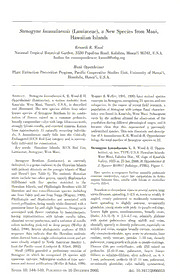
Stenogyne Kauaulaensis (Lamiaceae), A New Species from Maui, Hawaiian Islands PDF
Preview Stenogyne Kauaulaensis (Lamiaceae), A New Species from Maui, Hawaiian Islands
Stenogyne kauaulaensis (Lamiaceae), a New Species from Maui, Hawaiian Islands Kenneth R. Wood National Tropical Botanical Garden, 3530 Papalina Road, Kalaheo, Hawai‘i 96741, U.S,A, Author for correspondence: [email protected] Hank Oppenheimer Plant Extinction Prevention Program, Pacific Cooperative Studies Unit, University of Hawai‘i, Honolulu, Hawai‘i, U.S.A. Abs'i S ogy k daensis K. R. Wood & H. Wagner & Weller, 1991, 1999) have revised species Oppenheimer (Lamiaceae), a narrow endemic: from concepts in Stenogyne, recognizing 21 species and two Kaua‘ula, West Maui, Hawai‘i, U.S.A., is described subspecies. In the course of recent field research, a and illustrated. The new species differs from other population of Stenogyne with unique floral character¬ known species of Stenogyne Bentham by its combi¬ istics was found in Kaua‘ula, West Maui. Subsequent nation of flowers raised on a common peduncle, visits by the authors allowed for observation of the broadly campanulate calyx with large foliaceous teeth, population during different phenological stages, and it strongly falcate corolla, and exserted stamens. Known became clear that this represented a previously from approximately 15 naturally occurring individu¬ undescribed species. This new discovery and descrip¬ als, S. kauaulaensis easdy falls into the Critically tion of S. kauaulaensis K. R. Wood & H. Oppenheimer Endangered IUCN Red List category and is success¬ brings the total number of Stenogyne species to 22. fully cultivated for conservation. Key words: Hawaiian Islands, IUCN Red List, Stenogyne kauaulaensis K. R. Wood & H. Oppen¬ Lamiaceae, Stenogyne, West Maui. heimer, sp. nov. TYPE: U.S.A. Hawaiian Islands: West Maui, Lahaina Dist., SE slope of Kaua‘ula Stenogyne Bentham (Lamiaceae), as currently Valley, 1025 m, 23 Jan, 2008, H. Oppenheimer & delimited, is a genus endemic to the Hawaiian Islands Spencer H10817 (holotype, PTBG). Figure 1. Wife, primary diversity on the younger islands of Maui and Hawaii (see Table 1). The endemic Hawaiian mints include two other genera, namely Ha.plosta.chys Hillebrand with five species restricted to the Hawaiian Islands, and Phyllostegia Bentham with 32 Hawaiian and two extra-Hawaiian species including one from Tahiti and one from Tonga (Wagner, 1999). Phyllostegia and Haplostachys are associated with angled, evenly pubescent to moderately tomentose, insect pollination, being mostly white-flowered with a hairs spreading to slightly antrorse, occasionally prominent lower lip and slight fragrance. Stenogyne is glandular, young stems with pink- to purple-red tinge. associated with flower visitation by honeycreepers, Leaves light green, membranaceous, broadly ovate, having representatives with falcate corolla tubes, blades 3.5—7(—9) X 2.S-4.7 cm, adaxially glabrate abundant nectar production, and a variation of corolla with sparse pubescence along midrib and veins, colors including pink-red to deep purple (Weller & abaxially sparsely to densely pubescent, especially on Sakai, 1990). Recent phylogenetic analyses of DNA midrib and veins, margins broadly crenate, occasion- sequence data indicate that the Hawaiian endemic mints derived from a single colonization event and are cordate, rarely truncate, petioles 7-18 mm, densely most closek i el a ted to North American Stachys L. pubescent, young growth with pink- to purple-red tinge. from the Pacific coast (Lindqvist & Albert, 2002). Flowers (5)6 pm verticillaster, with (2)3 raised on Sherff (1935) provided a preliminary revision of peduncles (2-)5-9 mm, pubescent, bracts linear- Stenogyne in which he recognized 24 species with filiform to subulate-filiform, often reflexed, ca. 6 X numerous varieties. Subsequent studies of type spec¬ 1 mm, pubescent, pedicels (4—)7-ll mm, pubescent, imens and recent publications (Weller & Sakai, 1990; occasionalh glandulai. calyx tadially symmetrical, No von 18: 544-549. Published on 16 December 2008. doi: 10.3417/2008053 546 Novon (Lamiaceae)
